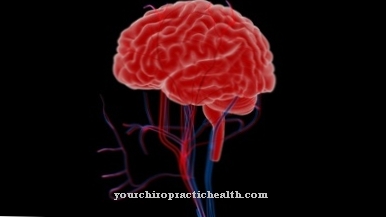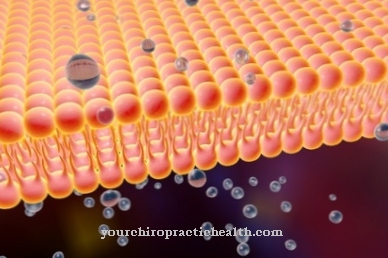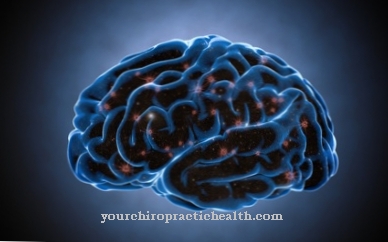The Afterload corresponds to the resistance that works against the contraction of the heart muscle and thus limits the ejection of blood from the heart. The afterload of the heart increases, for example, in the context of hypertension or valve stenosis. To compensate for this, the heart muscle can hypertrophy and promote heart failure.
What is the afterload?

The heart is a muscle that pumps blood into the bloodstream through alternating contraction and relaxation and is thus involved in the supply of nutrients, messengers and oxygen to the body tissues.
In order to limit the ejection of blood from the heart chambers, the so-called afterload counteracts the contraction of the heart chambers. All forces that oppose the ejection of blood from the heart ventricles into the blood vessel system are summarized as afterload. The ventricular myocardium has a certain wall tension. The wall tension at the beginning of the systole (blood ejection phase) is to be understood as the afterload of the heart under physiological conditions. In a healthy body, the wall tension of the ventricular myocardium overcomes the end-diastolic aortic pressure or pulmonary pressure and thus initiates the ejection phase.
The afterload in terms of wall tension reaches its maximum shortly after the opening of the aortic valve.
The value of the afterload is determined by both the arterial blood pressure and the stiffness of the arteries. The latter factor is also known as compliance. The preload must be distinguished from the afterload. It corresponds to all the forces that stretch the contractile muscle fibers of the heart ventricles towards the end of the diastole (relaxation phase of the heart muscle).
Function & task
Afterload is the resistance that the left ventricle must overcome shortly after the aortic valve opens to expel blood from the heart. The wall tension at the beginning of the systole regulates the blood ejection. In medicine, systole is the contraction phase of the heart. The ventricular systole consists of a tension phase and an expulsion phase (also known as expulsion phase). The systole thus serves to eject blood from the atrium into the heart chamber or from the chamber into the vascular system. The pumping capacity of the heart therefore depends on the systole, with two systoles each being interrupted by a diastole. The systole is around 400 ms at a frequency of around 60 / min.
The resistance to be overcome in the expulsion phase of the blood is the afterload, whereby the force for the systole depends on the ventricle volume in the context of the so-called Frank-Starling mechanism. The stroke volume of the heart also results from the peripheral resistance. The Frank Starling mechanism corresponds to the relationships between the filling and the ejection of the heart, which adapt the heart's activity to short-term pressure and volume fluctuations and allow both heart chambers to eject the same stroke volume.
If, for example, the preload increases, resulting in an increased end-diastolic filling volume of the ventricle, the Frank-Starling mechanism shifts the reference point on the relaxation curve towards the right. So the curve of the maximum support shifts to the right. The increased filling allows for larger isobaric and isovolumetric maxima. The ejected stroke volume increases and the end-systolic volume increases slightly.
An increase in the preload increases the pressure-volume work of the heart. The afterload increases. This increased resistance to ejection depends on the mean aortic pressure. With increased afterload, the heart must achieve a higher pressure up to the opening of the pocket valve during the tension phase. Due to the increased contraction force, the stroke volume and the end-systolic volume decrease. At the same time, the end-diastolic volume increases. The subsequent contraction in turn increases the preload.
Illnesses & ailments
Clinically, blood pressure is usually used to estimate the afterload or wall tension. The determination of the blood pressure at the beginning of the expulsion phase on the myocardium (heart muscle) only allows an approximation to the actual afterload values. The exact determination of the impedance is not possible. The afterload in everyday clinical practice is also approximately estimated using transesophageal echocardiography.
In cardiac insufficiency, the systolic force of the heart muscle is no longer related to the diastolic filling volume as required. As a result, blood pressure no longer reacts appropriately to stressful situations. This phenomenon initially characterizes exercise-dependent cardiac insufficiency, which can become rest insufficiency over time. In the case of pronounced heart failure, it is no longer possible to maintain blood pressure at rest and cardiac-related hypotension sets in, i.e. a loss of tone. In contrast, hypertension in the sense of increased tone increases the afterload. The heart has to increase its ejection performance with such an increase in tone, but only meets this requirement to the extent that its power development possibilities are sufficient. In coronary heart diseases, the oxygen supply and in cardiomyopathy the muscle strength counteract this aspect as a limiting factor. Too high an afterload accompanies numerous heart diseases.
The afterload increase can be regulated to a certain extent with medication. AT1 blockers, for example, are considered therapeutic afterload reducers. ACE inhibitors, diuretics and nitroglycerin reduce both the preload and the afterload. In addition, arterial vasodilators such as calcium antagonists of the dihydropyridine type can lower the afterload of the heart. Vasodilators relax the vascular muscles and enlarge the lumen of the vessels. ACE inhibitors, in turn, lower blood pressure, thereby reducing the afterload of the heart's work. Therefore, they are often used to treat heart failure, but are also used in coronary heart disease. AT1 blockers are competitive inhibitors and act selectively on the so-called AT1 receptor, where they antagonize the cardiovascular effect of angiotensin II. Above all, they lower blood pressure and reduce the afterload accordingly.
The afterload increases not only through hypertension, but also in the context of valve stenosis. According to Laplace's law, the ventricular musculature increases to compensate for a chronically increased afterload in order to counter-regulate and reduce the increased wall tension. As a result, the affected ventricle can dilate, which in turn leads to heart failure.








.jpg)



















